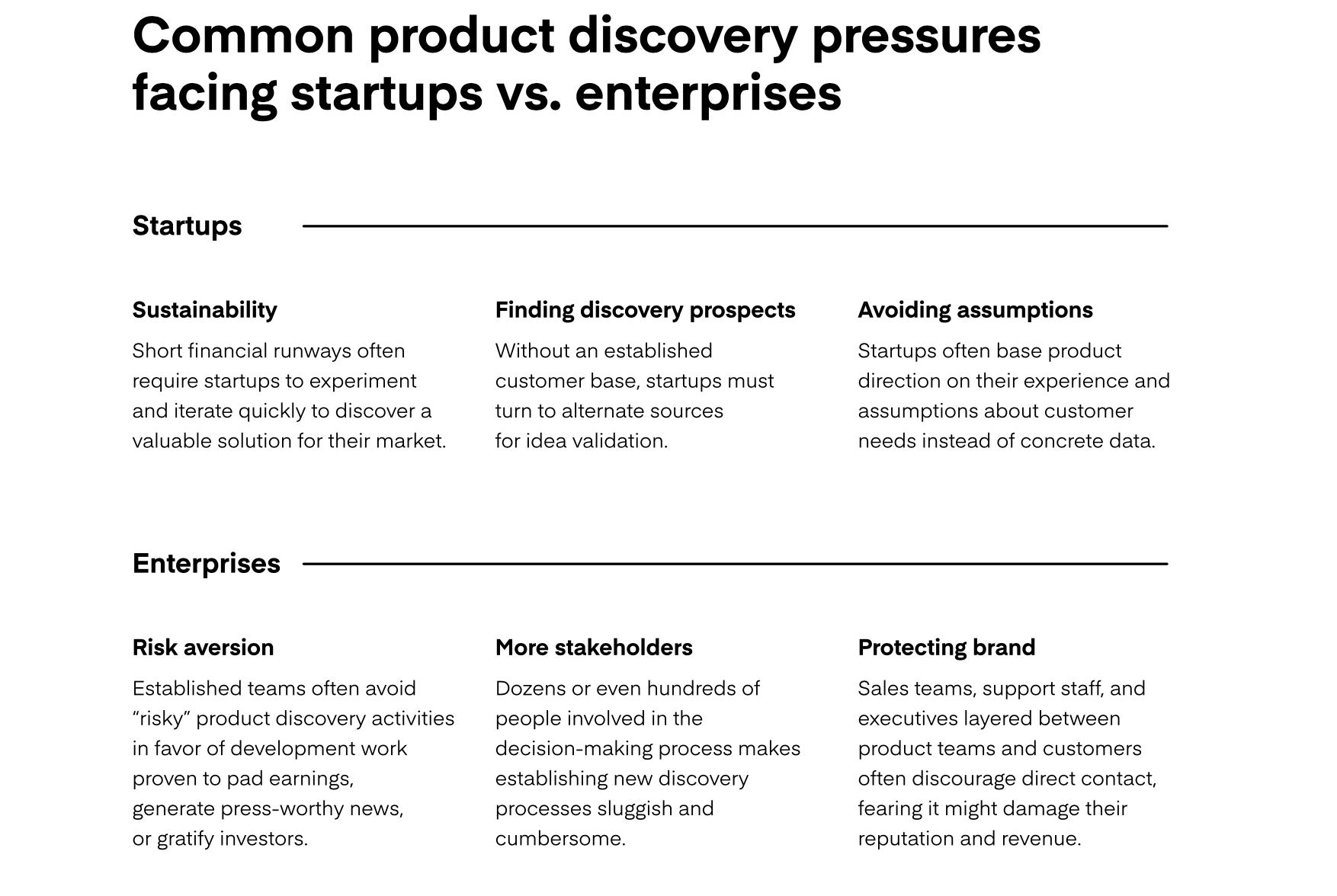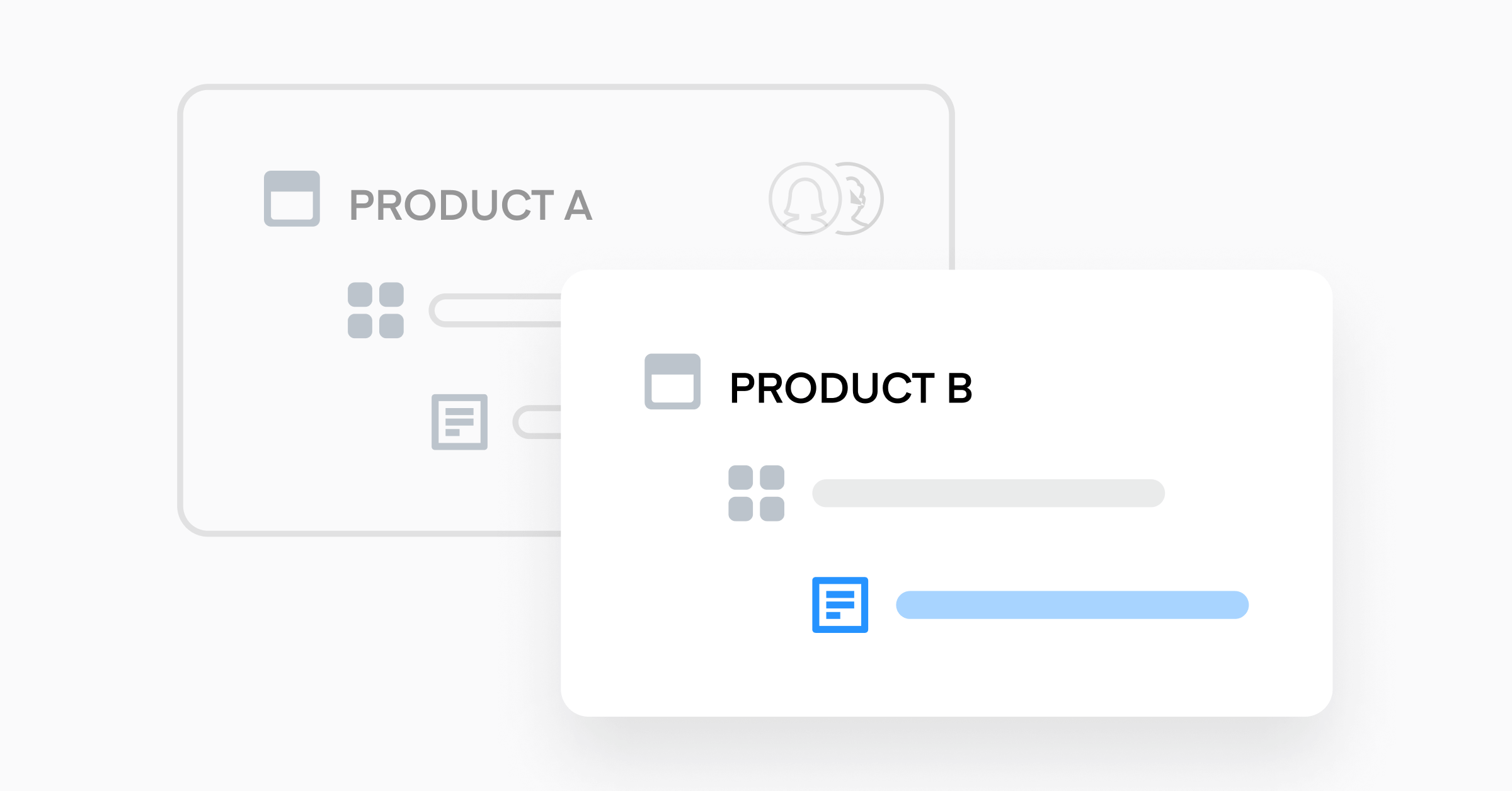How to tailor product discovery to your organization stage & size

This piece is an excerpt from “The Product Discovery Playbook.” For more insights and how-tos on product discovery, download the full ebook.
As companies grow and products mature, the problems teams face around identifying and validating new product ideas change—and best practices must adapt to accommodate those challenges.
Just because an organization is more substantial doesn’t mean they are doing product discovery better.
The good news: while the approach to product discovery might change as companies grow, the techniques and tactics for discovering innovative products and features largely remain the same.
Whether you’re a fast-growing startup exploring your market or an established team seeking to optimize discovery across your organization, here’s everything you need to know.
How to do product discovery as a startup
For early-stage companies, product discovery is all about reducing the risk of running out of time and money before finding product/market fit. Discovery helps them allocate resources towards what matters and find product/market fit in a fast, cost-effective way.
Instead of starting with an idea and aiming to validate whether it can be a success, founders should start with a specific group of customers they’d like to serve and a rough problem they’d like to solve, then use product discovery techniques to eliminate risk and uncertainty around how to solve that problem.
Early-stage companies should spend at least 25-50% of their time on product discovery.
Here’s how you can hack your discovery process when building an all-new product:
Start where your prospective customers already spend time
Most startups aren’t pioneering an all-new market—there are many prospective customers already using competing solutions to solve their problems that you can tap into to validate or invalidate your ideas before building.
To validate your ideas, begin where your prospective customers are already spending time. Social media, private industry communities, trade shows, and offline meetups are all great places to talk with your ideal customers about their burning problems. You can also consider reaching out directly to competitors’ customers to ask what problems aren’t being solved by their current solution.
Say we rewind the clock to a time when Productboard hasn’t been built yet, but spreadsheets exist. To learn more about customer needs, we’d try to understand what product managers are doing in spreadsheets today and the kinds of problems they run into using them—feedback all over the place, unclear source of the truth, hard to make decisions with, doesn’t translate into a roadmap easily—then solve for those.
Fire bullets, then cannonballs
Startups fall into a common trap. They come up with a brilliant idea for a product—an idea that solves what appears to be a burning problem for a far-reaching audience. They frantically begin designing and coding an MVP, emerging months later to share their masterpiece with the market.
But customers are fickle, and many of these ideas (and businesses) don’t survive first contact with a market. Startups realize they had been building the wrong product from the beginning, and the cycle begins again with their next big idea.
Instead of concentrating resources into one single bet—firing cannonballs, as author Jim Collins describes—founders should first calibrate their line of sight by taking smaller shots.
“The ability to turn small proven ideas (bullets) into huge hits (cannonballs) counts more than the sheer amount of pure innovation.”
— Jim Collins
Going back to our Productboard example, we might eschew detailed prototypes in favor of showing prospects potential mockups along with other real-world artifacts like competitors’ products or features. This lets us quickly understand our customers and market without spending precious time building a product that may turn out to be a failure.
Avoid becoming an opinion-driven company
Typically, product-driven founders and CEOs have a lot of opinions on what the product should be. Some have great instincts—but a good many products end up driven more by hubris than truth.
In this situation, you should make sure you’re walking the CEO through the discovery experience. Include them in discussions and discovery activities, but make it clear the product direction should be driven based on data and learnings rather than opinions.
Intercom has an excellent product principle when it comes to this: stay opinionated but flexible. You can build a solution and have an idea of the best way your customers can use it, but also build in flexibility so your customers can use it in the way that best suits their needs.
How to manage product discovery within enterprise organizations
Product discovery in large companies is more heavily weighted towards validation. Enterprise organizations can be more deliberate and risk-averse around innovation efforts. Teams must contend with more stakeholders to align and more proxy layers between you and your customers. Many companies are also managing discovery across a portfolio of products and business groups—from newly-introduced products through the maturity cycle to an aged product’s eventual decline, discovery must be an ongoing process.
Here are a few ideas for bringing a discovery mindset to your organization:
Avoid silos by bringing the right people together early
Enterprise organizations commonly “innovate” by launching corporate innovation labs, discovery teams, and other special teams. The problem with this siloed approach is that new discoveries end up confined to a small group instead of benefitting the wider organization.
Avoid siloing your product discovery efforts by bringing the right people together from the beginning. Design, development, support, marketing, and sales representatives should all be involved in both ideation and validation, with product leadership acting as the glue bringing everyone together. For example, a designer might help interview or observe users testing a prototype, or a developer might have early knowledge of feasibility risks others might miss.
Keeping decision-makers in the loop from the beginning will be crucial for earning organizational buy-in and building alignment around your efforts and avoiding proxy layers forming between you and your customers.
Think about discovery opportunities as a portfolio of small bets
Enterprises typically have dozens, if not hundreds of competing priorities and objectives within their walls. Without organizational buy-in, your product discovery efforts can be halted before they have the chance to grow.
For each new discovery project, aim to generate some rough idea of the opportunity size, then prioritize your biggest opportunities around your overarching business goals. Say you were aiming to increase retention by improving product usability—you might prioritize discovery efforts that analyze how users interact with prototypes over conducting interviews.
By thinking about your efforts as a portfolio of bets rather than a single project that cannot fail, you’ll uncover the most valuable opportunities to pursue and simplify prioritization of those efforts against product delivery work.
Mitigate brand and revenue risk
Startups are often forced to shoot for the moon, but enterprises have the luxury of a built-in customer base for testing new ideas. Of course, that doesn’t mean haphazardly rolling new ideas out to production.
Marty Cagan suggests a few techniques for mitigating risks to reputation and revenue during product discovery:
- Run A/B tests with a limited number of exposed customers
- Consider running invitation-only live tests when validating new features
- If necessary, utilize a formal customer development program under NDA
- Beta programs enable product teams to get feedback from a small group of customers before going fully out to market
Get your copy of “The Product Discovery Playbook” — our most comprehensive guide to product discovery yet.





